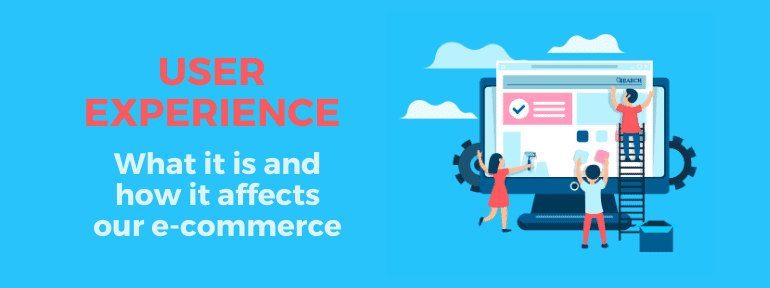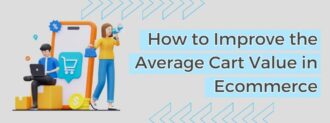The design of online stores is increasingly focused on a better user experience. It’s a fact that the usability factor affects the sales of an e-commerce and that is why it’s so fashionable lately. But how does user experience affect the SEO of my online store?
Table of contents
What is user experience?

Let’s start at the beginning. The concept of user experience describes a process that analyzes the actions or processes that a user applies, in this case, in an online store.
User experience is about measuring the usability of a website, what actions a user performs to reach their goal (in this case, completing the purchase), what problems they may encounter along the way and how to improve it.
This concept is becoming more and more important, since a better usability results in a much higher conversion.
At this point and once we know the concept, now it’s time to improve the user experience . To do this we have to understand the visitor of our online shop and make things easy for them. How do we do this? Let’s go!
This is an aspect that isn’t taken into account when building a website and, in particular, an online store, even though it’s a fundamental factor. The simple fact of building a menu adapted to the needs of the user and that makes easy to find what you want, helps a lot to improve the user experience.
The number of clicks the user has to make to get to your landing page is also very important. The fewer clicks, the better. In fact, it’s a very importante SEO factor, since Google understands that a depth greater than 4 clicks is a bad user experience and a not so important content. Therefore, it might not rank as high as it could.
Responsive design

Another very significant aspect: have you seen in your Analytics that you’re receiving more and more visits from mobiles? This trend is growing. Some data to make it clearer: in 2013 there were more than 30% of sessions on average from mobile devices. Currently in some niches it exceeds 60%.
That’s why you have to think about the mobile user. We don’t behave in the same way in front of a computer as we do with a smartphone in our hand.
Online store designs are becoming more and more mobile friendly. Large images, easily clickable elements and usable menus.
There’s another very important aspect to take into account: smartphones’s loading time (WPO). A good loading speed will help us to rank in Google, since a fast loading will reduce the bounce rate and, therefore, improve the user experience of our visitors.
“Do you want to know how to position your online store? In this post we tell you how: Tips for positioning your online store“.
One of the ways to make our website fly like a jet plane in its loading times is to apply AMP in the mobile version of your blog, which is an important part of your e-commerce strategy.
Breadcrumbs
Breadcrumbs help the user to locate the page within the website. The use of breadcrumbs is essential to improve the user experience and facilitate navigation within the online store.
In addition, with correctly marked breadcrumbs Google will also understand and like your website better. And what happens when Google likes something? Exactly, we rank better and improve our SEO.
Call to action
OK, we’re getting visitors to our online store. OK, we have a very cool and usable menu. OK, we have a super careful depth of clicks in which the user is able to reach any part of the web in less than 3 clicks. But let’s get to the important thing: we want the user buys our products.
We have to make sure that the calls to action are always accessible. In the case of an e-commerce, we’re talking about the button “Buy” or “Add to cart”. Also, the cart should always visible and, if it’s in the mobile version, visible, large and easily accessible.
A good solution for the mobile version is that the user doesn’t need to scroll to add the product to the cart, but that they can see the call to action of the buy button at a glance.
Checkout

This is essential. We have the customer on our website, they’re comfortable, adding products to the cart and wanting to buy. Well, hey, now you have to finalize the purchase and this should be as easy and comfortable as possible. And with this, I mena: we must avoid multiple pagination and endless forms.
For PrestaShop we can use a One Page Checkout Module which allows the checkout process to be done on the same page.
How does the user experience affect on an online store?
After understanding what user experience is and how to improve it, you’ll want to know what it can bring to your e-commerce. Well, just keep reading!
Customer loyalty
A good user experience has a very positive effect on your customers and also on potential customers.
One of the consequences of applying good practices in terms of experience is that you’ll achieve loyalty. Yes, loyalty, your customers will come back because they’ll be satisfied with the experience of the whole buying process, from the moment they arrive, through choosing the products, to the moment they receive them.
Congratulations! Loyalty is very difficult to achieve and you’ve just done it by improving the user experience of your online store.
Higher conversion

Another of the consequences of applying good user experience practices in your online store is to increase the time users spend in it. Yes, the customer will browse more and see more products, more categories, more offers and promotions. Indeed, this raises the possibility of finding more products to buy and of course, that they might buy much more.
Conclusion
Improving the user experience of your e-commerce is all the rage. Making life easy for the user in our online store benefits both, us as website owners and the customer. And, as we said, Google also likes a good user experience for visitors, rewarding us with a better ranking.
So, do you apply techniques to improve the user experience in your online store? Tell us about it in the comments!
Related Posts










Deja un comentario